Somalis
History of
the Somali
Beginnings
Early articles on the breed
The
Somali: CFA's Newest Championship Breed
The Search for Roots
My
Five Years as a Somali Breeder
Characteristics
What is a Somali like?
Genetics
Where did the Somali originate?
Colors in
which the Somali is available
Health of
the Somali
Color
Study What should the proper color for a fawn
Somali look like? Participate in the discussion!
Other Sites
Cat Fanciers Assoc.
SOMALIS:
The Search for Roots
by Patricia Nell Warren
First
published in "Cat World" Magazine, 1977. Reprinted here with
permission of the author.
Few new breeds have stirred up such an uproar as the Somali.
Mere mention of the cat often touches off hot discussions. Fanciers who have never seen a Somali, and judges and board
members who have never handled one - - all have heard about Somalis, and even
have firm opinions about what they are.
Today there are around 150 Somalis registered with Cat Fanciers Association
(CFA) and roughly 100 registered in Canada (some of these Somalis are
registered in both countries). The
breed has championship status in CFF, Crown, NCFA, ICF, and CCA.
Recently, the ACFA board voted to give the Somali championship status
effective with the current season. Currently,
provisional status is being applied for in CFA.
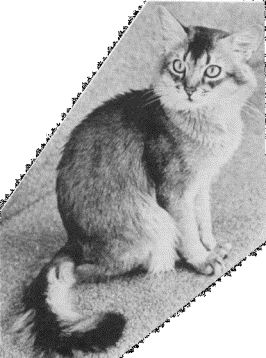
Meanwhile, Somalis are increasingly visible at CFA shows all over the country. Recently, in Chicago, 17 cats showed up. Eleven were judged at the Greater Sussex show in Kenilworth, New Jersey, on May 30. (Breeds which do not yet have championship or provisional status in CFA may still be exhibited in the newly created Miscellaneous Division. In this category, which is akin to AOV in other associations, the judges handle the cats and hang place ribbons. They may also have an informal discussion with the breeders during the ring about the proposed standard and other matters. These discussions, which are not permitted during championship judging, are a way for the judges to learn about the new breed.)
Interest in Europe is growing. This
spring, the first breeding pair of Somali kittens, a ruddy male named FOXTIL
STAR TREK and a ruddy female named JUNEE NOEL was shipped overseas. The buyer was Jutta Broisch, a FIFE breeder living in
Cologne, Germany. Mrs. Broisch,
who also breeds Abys and Chinchilla Persians, plans to exhibit and promote
Somalis in Europe.
Yet the hot debate continues. What
is the Somali?
The cat is a longhaired Abyssinian. The
original Somalis were thrown from pairs of registered Abyssinian parents. The cat has a silky soft, medium-long coat.
Like the Aby, it comes in ruddy or red, and has gold or green eyes.
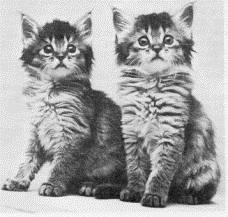
But the Somali is an Aby that is “ever so much more so.”
In the deep plushy coat, the ruddy hue gets a depth not possible in a
shorthair. The ticking is richer:
up to 12 bands on a single hair. When
the Somali has black ear-tufts, they are longer and lynx-ier than the Aby’s
ear-tufts. The cat has a distinctive tail:
long and very full, like a fox’s brush; it is club-shaped at the tip,
and mostly black. As the cat
moves, the ticked coat breaks apart like sheared beaver to display the ruddy
undercoat dramatically.
In short, the Somali doesn’t resemble any other longhaired cat.
However, the Somali differs from the Aby in a couple of small ways.
A Somali usually runs larger than the Abys in its line. The kittens are born with nearly-black shading over the
entire area that will later be ticked. They
don’t start to lighten and show their ticking till nearly 15 weeks.
Finally, they develop more slowly than Aby kittens.
In a litter of Aby kittens, a big black horsey Somali kitten stands out.
He can already be distinguished from the others when he is a day old.
His fur has a flattened, silky, shiny look, with waves around the neck
and down the back, even on the forehead.
By contrast, the Aby kittens are lighter and redder, and their fur has
a matte look.
These longhair Abys have appeared in a number of championship lines in both
the U.S. and Canada. How is it
possible?
TEN YEARS AGO
The Somali story started in 1967 when Abyssinian breeder Evelyn Mague was
doing volunteer work at an animal shelter near her home and cattery in
Gillette, New Jersey.
One day someone brought in an adult male cat.
The cat had already been bounced through five homes.
Now it was to be either adopted or destroyed.
Mrs. Mague looked the cat over and realized that it was a longhaired
Abyssinian. She had heard they
existed, but had never seen one.
“It was the most beautiful cat I ever laid eyes on,” she says.
She named the cat GEORGE and found him a good home, where he was altered.
Then, intrigued, she traced the cat’s origins.
GEORGE had been born in the Lo-Mi-R Cattery and sold as a pet.
He had been the only longhair in a litter of normal shorthaired
kittens. And, to her amazement,
Evelyn found out that GEORGE’s parents were both residing in her own
cattery! The sire was an Aby of
her own breeding, LYNN-LEE’S LORD DUBLIN.
The dam was LO-MI-R’S TRILL-BY, recently bought by her.
So both “DUBBIE” and TRILL-BY carried the recessive longhair gene.
Mrs. Mague started working with DUBBIE and TRILL-BY to get more Somalis. Eventually, they would produce five.
Meanwhile, in Canada, CCA judge Ken McGill had become aware of the longhair
gene in the Canadian Aby lines. He
was able to purchase a male Somali kitten, TUTSEITA, from the May-Ling
Cattery. TUTSEITA was to found the oldest Somali line, and now appears
on 25 per cent of all Somali pedigrees.
Bred to an Aby female of McGill’s, TUTSEITA sired an Aby daughter, DUNEDIN’S TORRI. (When a homozygous longhair is mated to a homozygous shorthair, the result is always shorthair kittens who are heterozygous for longhair). Bred back to her father, TORRI produced a male longhair kitten, DUNEDIN MOSEPH. McGill sold MUSEPH to breeder Don Richings, Dorchester, Ontario. At the Don-Al cattery, MOSEPH sired a number of cats, both Abys and Somalis, that are behind many Somalis today.
Meanwhile, back in the U.S., Mrs. Mague was still investigating the Somali
roots. She discovered that these longhairs had been appearing as
early as the mid-1950’s. Several
prominent Aby breeders told her privately that they had had them.
They said they had the kittens destroyed, or sold them as pets, and
altered the parents as they didn’t want the longhair gene in their line.
(Ironically, all breeders who did this were eliminating one of the
Aby’s salient features, its plushy coat.
It is now known that an Aby doesn’t have a plushy coat unless it is
heterozygous for longhair).
Mrs. Mague began to feel that this longhair cat should be recognized, not
wiped out. She christened the
breed “Somali” as a tribute to the possible African roots of the
Abyssinian.
For a year, she ran an ad in “Cats Magazine” saying she would buy longhair
Abys. Not one person answered it.
By the early 1970s, however, a few new Somalis were trickling in from
lines like Du-Ro-Al, Saika Shams, Saffron, Toujour, Lapinchat.
In all their pedigrees, certain Aby names kept cropping up, and Mrs.
Mague suspected that all Somalis might have a common root.
SOMALI CLUB
FOUNDED
In 1972, the Somali Cat Club of America was founded and Evelyn Mague was
elected President. By 1973 it had
twelve members.
As the Somali people began pressing for recognition, however, they ran into
heavy flak, mainly from some Aby breeders.
These critics felt strongly that the Somali should be recognized only as a
hybrid, or not at all. They
insisted that the Somali was a hybrid, not a purebred Aby.
They alleged that some North American breeders had falsified pedigrees
and introduced Persians into their lines.
The reason: to preserve
the Aby’s typical plushy coat, which had been disappearing.
So, the critics said, the Somali could not possibly breed true to color
because of the Persian in its background.
These arguments prompted the Somali Cat Club members to launch a task force of
historical and genetic research on their cat.
Last year, Walter Del Pellegrino, a New York member who also belongs to the
Empire Cat Club, undertook an analysis of all Somali pedigrees.
His study, entitled “Genesis”, was published by the club in the
spring of 1977 and stirred up more discussions.
As Mrs. Mague had suspected, Walter found that Somalis registered so far trace
back to MAY-LING TUTSEITA, or to four Abys at stud in the 1960s.
These Abys are: CHOTA-LI’S
R.S.T., SHERAMAN’S DABTU, DALAI ROBIN OF MEHITABEL and RING’S ABI ABDEL OF
SELENE. Each of these four Abys
have sired a number of heterozygous Abys who, in turn, threw Somalis.
So each of them probably carries the longhair gene.
In turn, all five of these early cats have a common background.
They go back through May-Ling, Shermax, Selene, and other early lines
to a single Abyssinian imported from England in 1952.
This was RABY CHUFFA, bred by Lady Barnard and bought by Mrs.
Schuler-Taft of Selene.
Judging by Walter’s study, RABY CHUFFA may well have brought the longhair
gene to North America. A curious
note: all five Somali lines have thrown reds, and RABY CHUFFA sired
one of the first reds shown in North America.
Another curious note: one
old-time U.S. Aby breeder told Somali Club members that all her early Somalis
came from imported cats.
Another conclusion can be drawn from Del Pellegrino’s study. If any U.S. or Canadian Aby breeders used Persians, they could have done it only during the three of four generations between CHUFFA’s importation and the birth of TUTSEITA, et al. Would there have been time, during those three or four generations, to outbreed to Persians, then recover Aby show quality and come up with a top cat like R.S.T.? Somali breeders doubt it strongly.
Crossbreeding with Persians would make a
mare’s nest of genetic problems for an Aby breeder.
The F1 generation would be a shorthair with the desired
plushy coat - - but it might be unshowable due to poor type and color.
The cat would look something like an Exotic Shorthair.
The breeder would then have to breed back to Aby.
Yet, from then on, any attempt to breed on his line and improve quality
would turn up Persian colors. And,
by the time he recovered Aby show quality, he would again be losing the plushy
coat. Since it is connected with
a recessive gene, the plushiness tends to disappear in successive shorthair-to-shorthair matings.
In fact, the only longhair that an Aby breeder could use without opening a genetic can of worms is - - the Somali itself. And, since Somalis were around in the 1950s and 1960s, they certainly would have been available for behind-closed-doors breedings. Their pedigrees didn’t even need to be falsified. They could have been registered as Abys and never shown, just kept quietly at home. Since they had Aby type and Aby color, they would have produced show-quality, plushy-coated kittens in the F1 generation. The only problem was: somewhere on down the road, any breeder who bred back on that line might get some surprise longhair kittens.
Another reason Somali breeders are skeptical about stories of Persian/Aby
breedings is their knowledge of the Somali genotype.
If there were Persians at the head of the five basic Somali lines, then
Somalis would have a high incidence of odd-color births.
Now and then, Abyssinians themselves do throw blues, silvers, lilacs,
but Somalis would have an even higher incidence of these unrecognized colors.
Yet this is not the case. Many
Somalis are the results of inbreeding, yet they breed as true to color as
their parent Abys do.
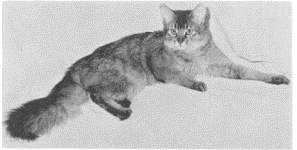
One Somali breeder, Andrea Balcerski, is noted for the exceptionally long coat
on her line. Ms. Balcerski has conducted a program of close inbreeding on her
line, working with both her Somalis and her original heterozygous Abys to
increase the coat length. In the
back of her mind, she now says, was the thought that these inbreedings might
also expose any odd colors back
in her line. Yet so far, she says, she has seen nothing but ruddies.
The unusually long coat and the absence of Persian colors in Ms.
Balcerski’s cats is a strong argument against the Persian theory.
Last, but not least, no one has ever come forward with any documented proof of
the alleged Persian/Aby crosses.
SOURCE
OF THE LONG COAT
The question remains then: how could the Somali have a long coat, yet be genotypically almost identical to the Aby?
Searching back into the Aby’s long and complex history, Somali breeders
think that they might have an explanation for this.
There are two periods when the longhair gene could have been introduced into
the Aby lines. In fact, according
to Rosemonde S. Peltz in her article “The Abyssinian Cat” in the 1972
“CFA Yearbook”: “The
appearance of longhaired Abyssinians should not be, and was not, a surprise to
knowledgeable breeders.”
The first possible period was in England after World War II.
The blitz had made a shambles of the cat fancy.
Only a dozen Abyssinian cats remained in the country.
So a British fancier may have been motivated to select cats of unknown
parentage to help build up Aby numbers again, just as Rosemonde Peltz states
they did in the late 1800s when they first developed the breed.
If a breeder selected an Aby-like or half-Aby shorthair cat with the
desired plushy coat, that cat probably carried the longhair gene.
Walter Del Pellegrino suspects a possible foundation registration, because he
has now carried his pedigree research back into the British cats behind RABY
CHUFFA. He found the search
difficult. Apparently, English
studbooks list only those cats that have won at show so, as such, are
incomplete.
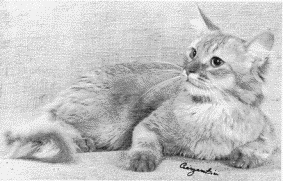
Despite all his efforts, Mr. Del Pellegrino found that he could not even put
together a complete third generation pedigree behind CHUFFA.
He came up with the following:
.
. .
CH BRUTON BILLIKEN
.
. .
|
.
. CH
ABOU
.
. |
|
.
. |
CH PIPBUN
.
. |
.
RABY ASHANTO
.
| |
.
| |
???
.
| |
|
.
| CROHAM
TCHIPS OF DJER-MER . |
. |
.
| .
???
.
|
CH
RABY CHUFFA OF SELENE
.
|
.
| .
CH ABOU
.
| .
|
.
| RABY
ASHANTO
.
| |
|
.
| |
CROHAM TCHIPS OF DJER-MER
.
| |
.
RABY TOSCA
.
. |
.
. |
???
.
. |
|
.
. ROVERDALE
TARA
.
. .
|
.
. .
ROVERDALE PURRKINS
***Editor’s note:
This is the pedigree as it appeared in the original article in 1977.
Further pedigree research has filled in some of the questions in Raby
Chuffa’s pedigree. See the
Pedigrees of Featured Cats section for his complete pedigree as it is now
known.
Using the same process of
elimination that he had used on the U.S. Aby/Somali lines, Mr. Del Pellegrino
concluded that if CHUFFA was a longhair carrier, he did not receive that gene
from his sire/maternal grandsire, RABY ASHANTO.
The reason: RABY ASHANTO
sired a number of other Abys who were exported to the U.S., yet
none of his other progeny appear on Somali pedigrees.
So Mr. Del Pellegrino
turned his attention to the Roverdale line.
ROVERDALE TARA was born in 1947, so ROVERDALE PURRKINS must have been born during or immediately after World War II. But Mr. Del Pellegrino was unable to discover any records of PURRKINS’ ancestry. Curiously, he found that two other people were also searching for PURRKINS’ pedigree. Yet, despite the efforts of three people, information on PURRKINS’ ancestry has yet to be found. Either the records were destroyed during the war, or they do not exist, in which case PURRKINS may be a foundation registration.
While tracking down British pedigrees, Mr. Del Pellegrino
also learned another interesting thing. Of
the 26 Abys sired in the United States by RABY CHUFFA OF SELENE only six are
shown by CFA records to have produced kittens.
Five of these cats are in what appears to be the line of longhair
ancestry leading from CHUFFA down to MAY LING TUTSEITA and the four Abys
singled out by Del Pellegrino’s “Genesis.”
The remaining 20 cats sired by CHUFFA were registered with CFA but no
litters were ever registered for them. In
a period when Aby breeders were working fervently to build up their breed, it
is curious that fully four-fifths of the get of an important sire have, in
effect, disappeared without a trace. Conceivably,
some of these cats might have been kept as pets and never bred.
But Mr. Del Pellegrino speculates that many of them might have been
altered after their first breeding because they threw longhair kittens.
Walter Del Pellegrino does not exclude the possibility that there are Aby longhair carriers outside the RABY CHUFFA ancestry. In “Genesis” he said: “I must hedge a bit because with the increased acceptance of the breed, more and more Aby breeders are unveiling their heretofore hidden longhair kittens.”
The longhair gene could also have been introduced still earlier in England, at the turn of the century. At that time, the Abyssinian was openly hybridized with Persians, Angoras, and a native British variety called the Bunny Cat. These matings were apparently done in the spirit of experimentation to see what kind of “delightful grizzled hues” (to quote one prominent fancier of the time) would turn up in the hybrids. The matings also resulted in a silver Aby variety that was recognized for a time as the Aby Chinchilla. These hybrid breedings are detailed in “Child of the Gods”, an authoritative history of the Aby written by Helen and Sidney Denham and published in 1951.
The Bunny Cat fascinates some Somali breeders because it may explain a couple of the oddities in the Somali.
While the Bunny Cat and the Aby
are often confused in cat breed books, the Bunny Cat was originally a distinct
variety. British judge Louis Wain
described them as very big cats, both shorthaired and longhaired, who were
born black and later lightened to an unbarred agouti coat.
So it is possible that the Somali’s size and its black kitten shading
are atavisms that throw back to the Bunny Cat.
So the Somali gene for coat length, if it is the result of hybridization, was probably introduced into the Aby lines at various points between the late 1800s and the late 1940s. Since then, generations of Aby-to-Aby matings have selected out nearly all the hybrid traces from the Aby genotype, including unwanted colors. The selection process, however, favored the survival of the longhair gene for a time, since the plushy coat was thought desirable by many Abyssinian breeders.
Still another Somali theory that was advanced by Don Shaw
in one of his “Cats Magazine” articles on genetics.
He suggested that the Somali might not be a true homozygous longhair.
The Aby coat, he felt, possessed some complex modifiers that could
sometimes “pile up” and produce individuals with longer coats.
If Shaw’s theory were
true, however, we would be seeing the true Aby shorthair coat cropping up in
litters from Somali-to-Somali matings. And,
in fact, some critics of the Somali have insisted that the cat does not breed
true as to coat length. However,
the Somali coat does breed true. Somali
coats also vary in length within the boundaries of “long”, but then so do
Persian, Angora, and Balinese coats.
“SHORTHAIR SOMALIS”
Still another fear voiced
by anti-Somali Abyssinian breeders is that “shorthair Somalis” will be
sold as Abys. “Shorthair
Somali” is the term unofficially applied to a shorthair cat who has one
Somali parent and one Aby parent. Some
Somali breeders have been using heterozygous Abys in their breeding programs
and these cats have mixed litters - - some longhair kittens and more
heterozygous shorthairs.
However, these fears about ”shorthair Somalis” getting into the Aby lines are groundless. The current CFA ruling is that the offspring of a Somali and an Aby must all be registered as Somalis regardless of coat length. So a “shorthair Somali” always carries a Somali registration number. It will be useless for an Aby breeding program and, therefore, threatens no one. It can be used only in a Somali program, or else it must be sold as a pet without papers.
Anyway, genetically speaking, the “shorthair Somali”
is simply a shorthair cat carrying the longhair gene.
It is not one whit different from the Abyssinian who has Aby parents
but who inherited the longhair gene from one of them. This latter is more of a threat to a fearful Aby breeder,
since it carries an Aby number and can carry its longhair gene into a lone
where it isn’t wanted.
However, there are two
ways to avoid a longhair carrier. One
is by a careful study of pedigrees. But
even this method is not fail-safe - - many Abys have a “Somali-type
pedigree” but did not actually receive the gene from a parent.
The best way is by a careful examination of coats before kitten
purchase, stud service, etc.
Somali breeders who have
worked with both shorthairs and longhairs know that there is a big difference
in the coat between an Aby that is homozygous for shorthair and an Aby that is
heterozygous for longhair. The
heterozygous Aby has a springy plushiness to its coat, owing to the greater
quantity of the thick sheared-beaver-like undercoat.
Some experienced Somali
breeders swear that they can go through a showhall, feel all the Abys’
coats, and tell which ones carry the longhair gene.
Aby breeders who wish to avoid buying any longhair carriers, therefore,
would do well to acquire this “feel” for the two different coats.
There is no need to deny the Somali its recognition on this ground when
it is so easy to tell the two genetic types apart.
SOMALIS OF NOTE
Amid the debates, the
breed is quietly establishing itself.
As yet, it has no “famous cats” in terms of the CFA
Top Twenty, but several Somalis have made themselves known in an unofficial
way. Show managers often use
Somalis in their pre-show publicity. At
the 1977 Empire Club show in New York,
for instance, Somalis were invited to be at the press preview and they
appeared on the TV network and in the New York daily papers.
One of the first Somalis
to be exhibited extensively in CFA was JUNE’S DANCING MOON, a ruddy male
bred and owned by June and Steven Negrycz of Brooklyn, N.Y.
This beautiful, first-generation cat has such startling color that he
was largely responsible for the first flush of excitement about Somalis in the
Northeast.
Recently, a Somali went Best Cat at a championship show for the first time. This was LYNN-LEE’S CHRISTOPHER, bred by Mrs. Mague and owned by Deborah Miller of New York. He went Best Cat under Pat Smith at the Chimneyville Cat Fanciers show at Jackson, Miss., in November 1976. Fittingly, CHRISTOPHER is a brother of GEORGE. Remember GEORGE? Both DUBBIE and TRILL-BY are now old, and CHRISTOPHER will probably be their last Somali kitten.
Several Somali breeders now have big catteries - - several queens, or more than one stud.
The cats are easy to work with - - gentle, affectionate,
soft-voiced, with all the familiar Aby traits.
They are generally enthusiastic about breeding.
Both males and females can be ready before their first birthday, though
most breeders wait till one year to breed a female.
Like Abys, Somalis are
vigorous and athletic. They do
not take kindly to confinement and overcrowding since they love free movement
and are very dominating among themselves.
Like Abys, Somalis are slow developers.
Most breeders don’t ship until 10 or 12 weeks,
The average litter size is small - - 3 or 4, with males predominating.
Somali color and ticking
develops very slowly. The rule of
thumb is: the “blacker” the
kitten then the better the color and ticking will be.
The full ruddy or red tone does not begin to flood the Somali coat
until around 8 or 9 months. The
full ticking and body development doesn’t come in until around 18 months. So a breeder must have extra patience and foresight in
selecting between the show/breed kittens and the pet-quality kittens.
When it comes to food, the Somali can have the Aby’s sensitive stomach. Somali breeders are extra-cautious about sudden changes in diet and starting kittens on solids. The soft Somali coat, and the color, are very sensitive to drying out. So it’s extra-important that the cats stay parasite-free and that they get enough fats in their diets. Other than that, Somalis need no special diet.
Likewise, Somalis seem to have no special health problems or congenital defects.
Grooming at home is not a problem. The Somali coat stays virtually tangle-free.
All that’s needed is a whisk of a steel comb at the breeches and
behind the elbows where matting might occur.
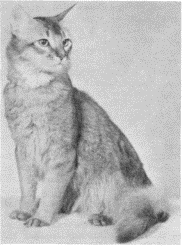
When it comes to show grooming,
Somali breeders disagree. Even
after a bath, the soft fur tends to separate into shaggy points, especially on
the chest. Some breeders don’t like this look; they use powder, then
comb it smooth. Other breeders,
however, feel that powder dulls the color and they like the shaggy look.
Shampoos can also be a problem.
Somali breeders have found that some shampoos fade the color sharply.
Human detergent shampoos, even baby shampoos, can do this.
Some of us use the special cat shampoos designed to highlight red
coats. Others also bathe several
days before the show in time for the natural oils to coat the hair again.
Still others use a light dressing with Dromorecide after a bath to
bring the color and ticking back up.
Since Somalis are
wiggle-worms like Abys, it is important to show kittens to get them used to
the hassles of the show hall.
When kittens are ready for
shipping, the Somali Club stands ready with its “kitten placement
service”. Few breed clubs make
such an effort to help their members place kittens in good breeding and pet
homes. Mrs. Mague is kept
up-to-date on what club members have kittens ready.
Then, when interested buyers contact her (often though our club ad in
the fancy magazines, or through club flyers handed out at shows), she can put
the buyers in touch with breeders immediately.
Often a great effort is made to find prospective buyers just the type
or outcross they want.
Now boasting over 70
members, the Somali Club recently went transatlantic with the joining of an
Aby breeder in Germany. One-third
of SCCA’s membership is Canadian. Some
members are active in CFA and known for other breeds such as Ann Kimball of
Utah with her Rex, Americans, and Folds.
Still others are Aby breeders who now advertise that they have Somalis
as well. Curiously, the SCCA
membership is heavily weighted towards youth - - the average Somali breeder is
40 or under.
The Somali Club also has
other services. In maintains a central pedigree file for research purposes.
It publishes a monthly newsletter with news and feature articles.
It sponsors rings and awards Best Somali ribbons.
Annually it makes awards to the top five Somalis on the club scoring
system. (On this system, a Somali
gets points only for actually defeating other Somalis).
Another organization for
the breed is the International Somali Cat Club which is a CFA club composed of
SCCA members and is working for breed recognition in CFA.
THE SOMALI LOOK
The appeal of the Somali seems
to lie in its “wild look”. The
Aby looks “wild”, too, but in a different way.
Its lean shape calls up an image of papyrus swamps and ruined temples -
- the Africa where its ancestors possibly roamed before being taken to England
by traveling fanciers. But the
shaggy-coated Somali calls up a different image:
deep pine forests, fallen logs, northern lights, snow.
There may be more than mere fancy to this feeling. The Bunny Cat is said to resemble hybrids between feral domestic cats and the small wildcat native to England and Europe, namely Felis sylvestris sylvestris.
If the Bunny Cat was a wild-domestic hybrid, and if the
Somali does trace back in part to the Bunny Cat, then yes…there is a little
bit of the wild in the Somali.
At any rate, the Somali
often appeals greatly to fanciers who would like to have an exotic cat, but
realize this is not practical. The
gentle Somali offers the possibility of owning a living room lynx without the
problems of temperament.
Since the Somali coat is
not Persian length, it displays the body under it to a great degree.
A well-muscled Somali (called
for by the standard), who has grown up with ample exercise, has a look of
strength and ripples with sinew.
So the Somali look, at its best, is the look of a wild animal in the prime of its vigor, bringing a breath of the northern woods to the breeder‘s home and the judging ring. v